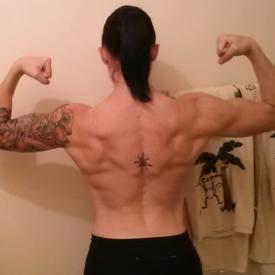Sell me (or otherwise) HIIT

Seffell
Posts: 2,245 Member
I've been doing only steady state cardio through the years (if any at all). Mostly brisk walking and stationary biking.
Can I ask for your experienced advice about switching to hiit or staying steady state, please?
I'm very interested in heart benefits, not just calorie burns.
Can I ask for your experienced advice about switching to hiit or staying steady state, please?
I'm very interested in heart benefits, not just calorie burns.
0
Replies
-
This is a great question. HIIT targets higher heart rate zones because of its intense short bursts of exercise over a 30 -45 min time period. You work at 100% for 30-45 sec with only short breaks helping to keep you in a higher heart rate zone for longer.
It also helps to burn adipose tissue (underlying fat) for the next 24 hours. No typical cardio program I know will do that for you.
I have increased cardiovascular health and leaner musculature by incorporating HIIT on a daily or every other day basis.
Hope this helps-
Sandy6 -
I do HIIT 2x per week for 30 min. It's brutal. Even after a year, it's still brutal. But I have found that it makes my other workouts easier (spinning, running, etc)1
-
https://www.nerdfitness.com/blog/cardio-vs-hiit-vs-weights-rebooting-our-research/
TL;DR- The most important exercise continues to be the one that you will actually do, and do safely. The real caloric battle happens in the kitchen.4 -
Why specifically HIIT?
There's lot's of options for interval training that aren't HIIT.
There's also plenty of options for high intensity cardio that aren't HIIT.
Yes I think you should (probably) incorporate some higher intensity work and interval training can be a good way to achieve that. Whether that's HIIT depends to a large degree on your capabilities and even enjoyment of different types of exercise.
You could simply do walk/run intervals or add some sprints into your stationary biking.
2 -
@SparkedUpFitness
There's actually an EPOC effect from steady state cardio too.
Cliff notes:
Summing Up
There is absolutely no doubt that higher intensity activity generates a larger EPOC, as measured by the percentage contribution. But like the fact that low intensity cardio burns a greater percentage of fat than higher intensity, this is misleading. 14% of a smaller calorie burn may still be smaller than 7% of a much larger burn. At the end of the day, outside of extremely unrealistic levels of exercise, the basic fact is that the absolute magnitude of the EPOC simply doesn’t amount to very much in the first place. One interval study, which found a 14% increase in metabolic rate via EPOC measured an irrelevant 32 calorie afterburn. Yayyy.
http://www.bodyrecomposition.com/research-review/research-review-effects-of-exercise-intensity-and-duration-on-the-excess-post-exercise-oxygen-consumption.html2 -
I went from Zumba twice a week (plus walking) last time I dieted for my wedding to HIIT/interval training twice a week (plus walking) when I've dieted this time around. The biggest difference seems to be inches lost, apart from my thighs (which are an inch larger and are fairly solid) I'm the same measurements (waist, hips, stomach, arms etc) as when I was 10 pounds lighter and look in better shape and feel fitter.
I don't know the pure definition/difference between HIIT and normal interval training but it's pretty hardcore (for me, also one of my colleagues actually had to leave to throw up during the first class because he pushed himself to far) it's short bursts short rests than a couple of minutes rest between sets and the class is about 50-60 mins including warm up/cool down and stretching. I like that it incorporates strength training mostly using your own body weight, some resistance bands etc with intense cardio. Definitely would recommend, I find it's as fun as zumba.
Our trainer also gives us a fitness tests once every 6-8 weeks to see how we've improved, how many push ups, sit ups and burpies we can do in a minute each, how long we can hold a wall sit and a plank, and how quickly we can do 3 sets of - 10 pressups, 10 squats, 10 lunges (each leg) 10 knee to elbow (each side) 10 burpees and 50 star jumps. It's great to gauge our progress and I have a little bit of friendly competition with my husband ;P1 -
Thanks everyone.0
-
I think a main benefit of adding some high-intensity work is developing an ability to do a wider variety of things. If you are only used to going slow and steady, you might get really challenged say, running to catch the train or racing up some stairs when you are late. Your muscles, heart, and lungs won't be used to quick bursts. I know personally that when I started doing high-intensity work, I went from the ability to run an 8 min mile tops to a 7 minute mile within a year, without working on running at all. I feel a lot more "up for anything" knowing that I regularly push myself really hard.1
-
Look into Tabata. 4 minutes, 3x/week gives peak benefits. It will dramatically increase vO2 max, and general fitness. It will probably be the worst 4 minutes of your week every time, but in terms of time efficiency, it doesn't get much better.1
-
gebeziseva wrote: »I've been doing only steady state cardio through the years (if any at all). Mostly brisk walking and stationary biking.
Can I ask for your experienced advice about switching to hiit or staying steady state, please?
I'm very interested in heart benefits, not just calorie burns.
For heart benefits, I've never seen a study that really shows any advantage to HIIT. Even low intensity steady state has heart benefits, and ramping up intensity doesn't change much other than the time factor. Obviously the lower the intensity, the longer the time needed to get true results.
An interesting article on steady state vs a couple of HIIT protocols below. But take note that the steady state is fairly high intensity and short for steady state work.
https://acefitness.org/certifiedarticle/6300/ace-sponsored-research-hiit-vs-steady-state/
It would be great to see a study that added in more low intensity steady state comparisons. But the study does show good benefits in VO2max and aerobic power output. So it gives you options of training towards the same end goals, which is great if you are like me and get easily bored with doing the same thing over and over.
For me personally, I like to mix it up and do some HIIT along with steady state stuff. I really hate the long and slow stuff so generally my steady state stuff is at least medium intensity, and from there I vary to medium and high intensity intervals, sometimes towards the end of the easier steady state stuff. I do agree with the thoughts from @CJ_Holmes that the higher intensity stuff, regardless of it being intervals or steady state, has helped me with overall improvements. I don't generally have to run to catch trains or up stairs, but do quite enjoy when guys half my age with superior equipment find out that sometimes the old guys on a crappy mountain bike can humble them in power output. 2
2
This discussion has been closed.
Categories
- All Categories
- 1.4M Health, Wellness and Goals
- 394K Introduce Yourself
- 43.9K Getting Started
- 260.3K Health and Weight Loss
- 176K Food and Nutrition
- 47.5K Recipes
- 232.6K Fitness and Exercise
- 430 Sleep, Mindfulness and Overall Wellness
- 6.5K Goal: Maintaining Weight
- 8.6K Goal: Gaining Weight and Body Building
- 153.1K Motivation and Support
- 8.1K Challenges
- 1.3K Debate Club
- 96.4K Chit-Chat
- 2.5K Fun and Games
- 3.9K MyFitnessPal Information
- 15 News and Announcements
- 1.2K Feature Suggestions and Ideas
- 2.7K MyFitnessPal Tech Support Questions







